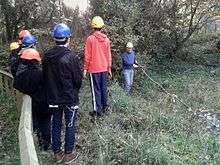London Wildlife Trust
London Wildlife Trust (LWT), founded in 1981, is the local nature conservation charity for Greater London. It is one of 46 members of the Royal Society of Wildlife Trusts (known as The Wildlife Trusts), each of which is a local nature conservation charity for its area.[1][2] The Trust aims to protect London's wildlife and wild spaces, and it manages over 40 nature reserves in Greater London.[3] One of its campaigns is to turn London's gardens into mini-nature reserves,[4] and it provides education services for schools. Local groups work on reserves and organise walks.[5]
| Founded | 1981 |
|---|---|
| Type | Charitable organization |
| Focus | Nature conservation |
| Location | |
Area served | London |
Key people | Gordon Scorer (CEO), Mathew Frith (Director of Conservation), Leah McNally (Director of Projects & Visitor Engagement), Richard Grindle (Chief Operating Officer), David Mooney (Director of Development), Elaine Sullivan (Chair) |
| Website | www |
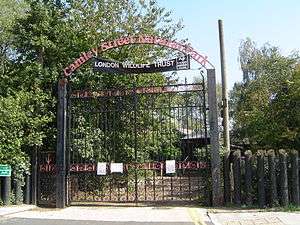
The Trust's oldest reserves include Sydenham Hill Wood, which was managed by Southwark Wildlife Group before 1982 and thus was already a Trust reserve at that date. The campaign to save Gunnersbury Triangle began that same year, succeeding in 1983 when a public inquiry ruled that the site could not be developed because of its value for nature.[6][7] The small Centre for Wildlife Gardening in East Dulwich has won an award for its work.[6] The Trust pioneered the systematic recording of data on wildlife and the environment in the capital. Its "Biological Recording Project" became the semi-independent "Greenspace Information for Greater London", known as GIGL.[6]
The Trust has some 50 members of staff and 500 volunteers who work together on activities as varied as water management, chalk grassland restoration, helping people with special needs and giving children an opportunity to go pond-dipping. The Trust collaborates with government agencies, local authorities, housing associations, commercial companies, building developers and sponsors to create plans and strategies at local, regional and national level, including the All London Green Grid and Biodiversity Action Plans.[9] The Trust's reserves receive over 230,000 visitors per year.[8][10] The trust is supported by over 14,000 members.[11]
In its strategy document, For a Wilder City. London Wildlife Trust 2015–20, the Trust sets out its vision and mission, as well as plans for a five-year period. The trust states its vision as: "A London alive with nature, where everyone can experience and enjoy wildlife."[8] It describes its mission in three parts as "Protecting, Restoring and Creating wild places for nature",[8] "Engaging, Inspiring and Enabling people to connect with nature",[8] and "Championing, Challenging, and Influencing people to stand up for nature".[8] Among its aims for protecting and restoring, the Trust intends to bring 30 of its reserves to "Favourable Condition" by 2020. It plans to restore the Sydenham and Norwood woodlands, and the "Living Landscape" of the Great North Wood as a part of The Great North Wood Project, and to reintroduce the water vole to the River Wandle.[14]
The Trust's aims for engaging and enabling include new visitor centres for the reserves at Camley Street, Gunnersbury Triangle, Woodberry Wetlands and Walthamstow Wetlands. and training young people in its "Wild Talent" programme.[15] Its aims for championing nature include creating a London development biodiversity standard, hosting the London Environment Educators' Forum, collaborating on projects across the city, and opening new reserves such as Byng Road (High Barnet), Braeburn Park (Crayford) and Crane Meadows (Heathrow). Recent projects have helped to support pollinators and to conserve the Welsh Harp reservoir.[16] The Trust has three permanent charitable objectives, namely the conservation of places and objects of scientific interest and natural beauty, and of biodiversity, in Greater London;[12] the education of the public, especially young people, in nature conservation, sustainability, and "the appreciation of natural beauty";[12] and research into nature conservation and the use of natural resources.[12]
Nature reserves
Key
Public access
|
Classifications
|
Sites
| Site | Photograph | Area | Location[lower-alpha 1] | Public access[lower-alpha 1] | Classifications | Description |
|---|---|---|---|---|---|---|
| Bellenden Road Nature Garden[17] | N/Av | Southwark 51.4725°N 0.0720°W TQ 340 766 |
BPA | The garden contains a variety of mini-habitats, including native hedgerow, a collection of logs for stag beetles, grassland, a mature woodland area and wildflower borders.[17] | ||
| Beverley Meads and Fishponds Wood[18] | 5.9 hectares (15 acres)[19] | Merton 51.4222°N 0.2496°W TQ 218 707 |
Yes | LNR[20] | Fishpond Wood has two ponds which may date from medieval times[21] and wetlands surrounded by mature oak and hazel woodlands. Beverley Meads is a mosaic of woodlands and acid grassland, which is a rare habitat in London, and is important for grassland butterflies.[20] | |
| Birdbrook Road Nature Reserve[22] | N/Av | Greenwich 51.4608°N 0.03255°E TQ 413 755 |
No | SINCM[22] | The site is a refuge for amphibians in London. Rocky banks of broken concrete (remnants of the reserve's industrial past) provide a habitat for basking lizards. Habitats include grassland, ponds, scrub and rocky banks. Species include great crested newt, palmate newt, smooth newt; slowworm and other lizards; yellow iris, biting stonecrop, crown vetch and cinquefoil; conehead and Roesel's bush cricket.[22] | |
| Braeburn Park[23] | 22.3 hectares (55 acres)[23] | Bexley 51.4451°N 0.1711°E TQ 510 740 |
Yes | SSSI[24] | The site is former sand quarries which have gradually reverted to nature. Habitats include ruderal scrub, grassland and woodland. There is a wide variety of invertebrates, including rare ones such as picture-winged flies.[23] Wansunt Pit, a geological Site of Special Scientific Interest, is in the park.[24] | |
| Bramley Bank[25] | 10.4 hectares (26 acres)[25] | Croydon 51.3527°N 0.05841°W TQ 353 633 |
Yes | LNR[26] | The site has acid grassland, woodland (mainly oak, ash and sycamore), and a pond. The margin of the pond has yellow flag and flote grass. Wildlife includes nutchatches, song thrushes, purple hairstreak butterflies, yellow meadow ants and pipistrelle bats.[25] | |
| Camley Street Natural Park[27] | 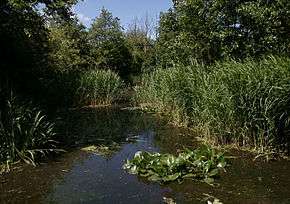 |
0.8 hectares (2.0 acres)[27] | Camden 51.5354°N 0.12751222°W TQ 300 835 |
Yes | LNR[28] | This small site is a former coal yard next to the Regents Canal and Kings Cross station. The habitats are woodland, meadow areas and ponds. It has a wide variety of plant and animal life, including bat species, and there are birds such as reed warbler, kingfisher, goose, mallard and reed bunting.[27] |
| Centre for Wildlife Gardening[29] | 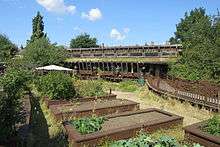 |
0.2 hectares (0.49 acres)[30] | Southwark 51.4627°N 0.07534°W TQ 338 755 |
PL | SINCB1[30] | Containing both a nature trail and a visitor centre that offers practical advice to city gardeners, this site also has a garden for visitors. The habitats include a mini-beast village, summer meadow, woodland copse, stag beetle sanctuary, wildlife pond and bog garden and flowery chalk bank.[29] |
| Crane Meadows[31][lower-alpha 2] | 13.0 hectares (32 acres)[31] | Hillingdon 51.4732°N 0.4162°W TQ 101 761 |
No | SINCM[33] | This site on the bank of the River Crane is close to Heathrow Airport. The habitats include grassland, scrub, old pasture, wet woodland, the river and ditches. There are small heath butterflies, and plants such as bugle, water-pepper and ragged-robin.[31] | |
| Crane Park Island[34] | 1.9 hectares (4.7 acres)[34] | Richmond 51.4436°N 0.3789°W TQ 128 729 |
Yes | LNR,[35] SINCM[34] | The island is heavily wooded, and also has a pond and areas of scrub and reedbeds. Mammals include the rare water vole, and other creatures such as kingfishers (a legally protected species), woodpeckers, frogs, damselflies and dragonflies are also found there.[34][35] | |
| Denham Lock Wood[36] |  |
6.3 hectares (16 acres)[37] | Hillingdon 51.5657°N 0.4808°W TQ 054 863 |
Yes | SSSI[37] | This site is mainly wet woodland, which is poorly drained and subject to flooding. The most common trees are alder and crack willow, with an understorey of mosses, ferns and herbs. In drier areas there is a hazel coppice shrub layer.[37] |
| Dews Farm Sand Pits[38] | 1.2 hectares (3.0 acres)[38] | Hillingdon 51.5836°N 0.4744°W TQ 058 883 |
Yes | SINCB1[39] | This site contains mainly acid grassland on the location of what used to be a mineral quarry, abandoned when sand and gravel extraction ended. The hollows and banks are now home to a variety of butterflies, hoverflies, grasshoppers and rabbits.[38] | |
| Frays Farm Meadows[40] | 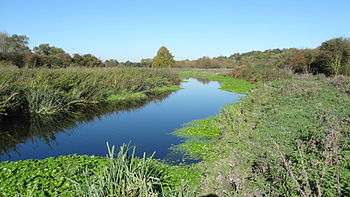 |
28.2 hectares (70 acres)[41] | Hillingdon 51.5630°N 0.4751°W TQ 058 860 |
Yes | SSSI[41] | The site has a variety of different types of grassland, ranging from grazed meadows to areas of marshy grassland with tall sedge. Ditches, hedges and a railway embankment provide additional diversity. There is a variety of butterflies, dragonflies and wildfowl.[41] |
| Greville Place[42] | 0.1 hectares (0.25 acres)[43] | Camden 51.5350°N 0.1882°W TQ 258 833 |
PL | SINCL[43] | Located in a small residential area surrounded by suburban gardens. Despite its size, the area includes a wildlife pond, mixed woodland, a woodland understory scrub layer and a woodland perennial layer. Species include stag beetle, lesser stag beetle, smooth newt, common frog and common toad.[42] | |
| Gunnersbury Triangle[44] | 2.6 hectares (6.4 acres)[45] | Ealing/Hounslow 51.4936°N 0.2714°W TQ 201 786 |
Yes | LNR,[46] SINCM[47] | This site has been cut off by railway lines since the late 19th century, and it has grown up naturally into birch and willow woods with a meadow, marshy areas and a pond. Mammals include field voles and wood mice, and there are a variety of birds and amphibians.[44] | |
| Gutteridge Wood[48] | 25.0 hectares (62 acres)[49] | Hillingdon 51.5461°N 0.4280°W TQ 091 842 |
Yes | LNR,[50] SINCM[51] | The site is a mosaic of woods and meadows, bisected by Yeading Brook. The trees are principally oak, with some ash and silver birch. The northern edge of the meadow has a variety of wild flowers. Birds include kestrels, great spotted woodpeckers and common kingfishers.[52] | |
| Hutchinson's Bank, Chapel Bank & Threecorner Grove[53] | 10.9 hectares (27 acres)[53] | Croydon 51.3322°N 0.01478°W TQ 384 611 |
Yes | LNR,[54] SINCM[55] | The site is a sloping grass bank, which has a wide variety of plants, butterflies and birds. Plants include the pyramidal and man orchids, and the greater yellow-rattle, which is rare nationally. Over 100 species of moth and 37 of butterfly have been recorded.[54] | |
| Ickenham Marsh[56] | 7.6 hectares (19 acres)[57] | Hillingdon 51.5552°N 0.4335°W TQ 087 852 |
Yes | SINCB1[58] | The marsh has tall herbs, soft rush and tufted hairgrass, with oak and ash woodland on higher ground. There are herbs such as skullcap, birds including blackcaps, and the long-winged conehead cricket.[56] | |
| Isleworth Ait[59] |  |
3.5 hectares (8.6 acres)[59] | Hounslow 51.4682°N 0.3213°W TQ 167 757 |
BPA | LNR,[60] SINCM[33] | This forested site floods regularly. It has more than 57 bird species, including the tree-creeper and heron. Two rare species of molluscs also live on the island: the two-lipped door snail and the German hairy snail, as well as several rare species of beetles.[60] |
| Mill Hill Old Railway[61] | 2.3 hectares (5.7 acres)[62] | Barnet 51.61246°N 0.254324°W TQ 20970 91847 |
PL | SINCB2[63] | This linear site has a variety of suburban birds, such as sparrowhawks, long-tailed tits, chiffchaffs and blackcaps. There are many hoverflies, butterflies including orange-tips and small copper, and slowworms.[61] | |
| New Cross Gate Cutting[64] | 4.2 hectares (10 acres)[65] | Lewisham 51.4702°N 0.03903°W TQ 363 764 |
No | SINCM[64] | New Cross Gate Cutting is predominantly a woodland area with smaller regions of neutral and acid grassland adjacent to areas of reeds and tall herbs. Species include kestrel, great spotted woodpecker and rosebay willowherb. The reserve includes over 170 different species of flowering plants, several of which are locally rare.[64] | |
| Oak Hill Wood[66] | 5.5 hectares (14 acres)[66] | Barnet 51.6409°N 0.1521°W TQ 279 952 |
Yes | LNR,[67] SINCB1[68] | It is an ancient woodland, dominated by pedunculate oak, hornbeam and ash. There is also an area of meadow which contains common wild flowers such as lady's bedstraw and common knapweed, butterflies including gatekeeper, common blue and large blue, and a number of bat species.[67] | |
| Old Ford Island[69] | N/Av | Newham 51.5364°N 0.02032°W TQ 374 838 |
No | SINCB1[70] | This site has woodland, meadow, tall herbs and scrub. It has a variety of breeding birds and is important for butterflies, including the small heath, small copper, wall and common blue.[70] | |
| Park Road Pond[71] | 0.4 hectares (0.99 acres)[72] | Hillingdon 51.5503°N 0.4712°W TQ 061 846 |
Yes | SINCB1[73] | Park Road Pond is a large pond surrounded by crack, grey willows and a few young oaks and alder. Species include dragonflies, toad, great crested newt, common frog, damselflies and pond invertebrates such as pond snail and whirligig beetle.[71] | |
| Riddlesdown SSSI[74] | 1.9 hectares (4.7 acres)[75] | Croydon 51.3217°N 0.09129°W TQ 331 598 |
Yes | SSSI,[76] SINCM[77] | Forming part of a large chalk grassland area, close to the boundary with Surrey, Riddlesdown hosts badgers, dormice and woodland birds. The site is a rare chalk grassland habitat with its associated species.[74] | |
| Saltbox Hill SSSI[78] |  |
6.9 hectares (17 acres)[78] | Bromley 51.3298°N 0.01814°E TQ 407 609 |
Yes | SSSI,[79] SINCM[80] | Part of the landscape that inspired Charles Darwin, Saltbox Hill contains downland and chalk grassland with an adjacent woodland area. The site is home to a variety of wildflowers, containing rare species such as pyramidal orchids, wild basil and quaking grass. Woodland species include woodpecker, nuthatch and treecreeper.[78] |
| Spencer Road Wetlands[81] | 1.1 hectares (2.7 acres)[82] | Sutton 51.3840°N 0.1634°W TQ 279 666 |
No | LNR,[83] SINCM[84] | The site has reed swamps with wetland vegetation, woodland, a sedge-bed and a pond. Insects include the twin-spotted wainscot and crescent moths, and there are birds such as grey herons, reed warblers and kingfishers.[81] | |
| Sydenham Hill Wood and Cox's Walk[85] | 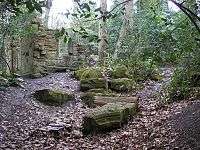 |
28.2 hectares (70 acres)[86] | Southwark 51.4356°N 0.06785°W TQ 344 725 |
Yes | LNR,[87] SINCM[88] | A Victorian folly and trees such a monkey puzzle show that this site was formerly the garden of a villa, but it also has ancient woodland, rare insects, and a variety of flowering plants, fungi, birds and mammals.[85] |
| Ten Acre Wood[89] | 11.2 hectares (28 acres)[90] | Hillingdon 51.5424°N 0.4195°W TQ 097 838 |
Yes | LNR,[91] SINCM[51] | Yeading Brook runs through this 100-year-old oak plantation, which has an underlayer of hawthorn and blackthorn. and areas of marsh and meadow. Birds include hobbies and kingfishers, and there are invertebrates such as Roesel's bush crickets and long winged coneheads.[89][91] | |
| Totteridge Fields[92] | 6.9 hectares (17 acres)[93] | Barnet 51.6315°N 0.2344°W TQ 223 940 |
Yes | LNR,[94] SINCM[95] | This site has hay meadows and hedgerows. There are many butterflies, and flowers include meadow-sweet, hardheads and buttercups. Ditches provide shelter for amphibians.[92] | |
| Uxbridge College Pond[96] | N/Av | Hillingdon 51.5508°N 0.4697°W TQ 062 846 |
No | SINCB1[73] | Heavily shaded by grey willow, weeping willow and sycamore trees, Uxbridge College Pond is home to many amphibians, including the great crested newt.[96] | |
| Uxbridge Moor[97] | 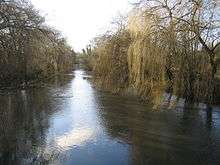 |
N/Av | Hillingdon 51.5407°N 0.4917°W TQ 047 835 |
Yes | SINCB1[98] | The site is on an island in the River Colne. It has two meadows and willow woodland. There are common plant species such as oat grass, couch grass, nettles, but also some rarer ones such as hammer sedge. Birds include kingfishers, and butterflies the speckled wood.[97] |
| The Warren[99] | 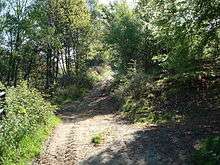 |
13.5 hectares (33 acres)[100] | Bromley 51.3925°N 0.1345°E TQ 486 681 |
Yes | SINCB1[101] | Once a part of the Kevington Manor Estate, The Warren is now home to green woodpecker and nuthatch, dragonflies and damselflies. Habitats include oak and birch woodland, a pond and acid grassland with a ground flora of bracken and wildflower.[99] |
| West Kent Golf Course[102] | 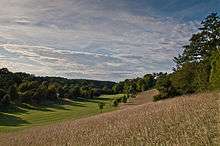 |
6.3 hectares (16 acres)[102] | Bromley 51.3293°N 0.04826°E TQ 428 609 |
FP | SINCM[103] | West Kent Golf Course's habitats include chalk grassland, woodland and scrub. Over 28 species of butterfly have been documented on site, including the rare small blue. Species of rare wildflower are also in abundance, with wild thyme, yellow rattle and swathes of orchids found around the site.[102] |
| Wilderness Island[104] | 2.7 hectares (6.7 acres)[105] | Sutton 51.3723°N 0.1596°W TQ 282 653 |
Yes | LNR,[106] SINCM[84] | The habitats on this site are woodland, meadows, ponds and a river. The ponds are an important habitat which have a variety of wetland plants and trees include a black poplar, which provides a habitat for the rare hornet clearwing moth. Butterflies include the speckled wood and holly blue.[104] | |
| Woodberry Wetlands[107] |  |
12.0 hectares (30 acres) | Hackney 51.570301°N 0.088585317°W TQ 325 874 |
Yes | The site has a large lake used by many birds such as pochard, shoveller and gadwall. Amphibians include frogs, toads and newts, and there is a wide variety of invertebrates such butterflies, moths, dragonflies and damselflies. A rare species on the site is the red-eyed damselfly.[107] | |
| Yeading Brook Meadows[108] | 17.0 hectares (42 acres)[108] | Hillingdon 51.5288°N 0.4113°W TQ 103 823 |
Yes | LNR,[109] SINCM[51] | The site is mainly grassland, with a variety of wild flowers such as the narrow-leaved water-dropwort and common spotted orchid. Invertebrates include Roesel's bush-cricket, shield bug and skipper butterflies, and there are birds such as skylark and snipe.[108] | |
Sites formerly managed by the Trust
See also
- List of Local Nature Reserves in Greater London
- List of Sites of Special Scientific Interest in Greater London
Notes
References
- "About London Wildlife Trust". London Wildlife Trust. Archived from the original on 25 March 2016. Retrieved 2 June 2016.
- "Map of Wildlife Trusts". The Wildlife Trusts. Archived from the original on 17 November 2017. Retrieved 2 June 2016.
Each of the 47 Wildlife Trusts is an independent, autonomous charity with its own trustees, whose primary concern is the conservation of nature within its own geographical area.
- "Find a nature reserve". London Wildlife Trust. Archived from the original on 23 July 2014.
- "London's Gardens". London Wildlife Trust. Archived from the original on 29 March 2015. Retrieved 22 May 2016.
- "Volunteer with us". London Wildlife Trust. Archived from the original on 24 March 2016. Retrieved 22 May 2016.
- Frith, 2012
- Goode, David (2014). Nature in Towns and Cities. William Collins (New Naturalist). pp. 304–308. ISBN 978-0-00-724240-5.
- For a Wilder City, p. 5
- For a Wilder City, p. 4
- London Wildlife Trust, Annual Review, 2008–2009 Archived 7 August 2011 at the Wayback Machine
- For a Wilder City, p. 16
- For a Wilder City, p. 19
- "Headstart courses". EDT. Archived from the original on 17 March 2016. Retrieved 15 March 2016.
- For a Wilder City, pp. 6–8
- For a Wilder City, pp. 9–12
- For a Wilder City, pp. 13–16
- "Bellenden Road Nature Garden". London Wildlife Trust. Archived from the original on 6 September 2015. Retrieved 8 August 2015.
- "Beverley Meads and Fishponds Wood". London Wildlife Trust. Archived from the original on 26 March 2016. Retrieved 8 August 2015.
- "Map of Fishpond Wood and Beverley Meads". Local Nature Reserves. Natural England. Archived from the original on 30 January 2016. Retrieved 8 August 2015.
- "Fishpond Wood and Beverley Meads". Local Nature Reserves. Natural England. 4 March 2013. Archived from the original on 9 January 2014. Retrieved 8 August 2015.
- "Beverley Meads and Fishpond Wood". London Parks and Gardens Trust. Archived from the original on 19 October 2013. Retrieved 9 January 2014.
- "Birdbrook Road Nature Reserve". London Wildlife Trust. Archived from the original on 6 September 2015. Retrieved 8 August 2015.
- "Braeburn Park". London Wildlife Trust. Archived from the original on 5 September 2015. Retrieved 8 August 2015.
- London Wildlife Trust. "SINC Review". London Borough of Bexley. p. 116. Archived from the original on 25 January 2016. Retrieved 18 January 2016.
- "Bramley Bank". London Wildlife Trust. Archived from the original on 13 March 2014. Retrieved 8 August 2015.
- "Bramley Bank". Local Nature Reserves. Natural England. 1 March 2013. Archived from the original on 13 March 2014. Retrieved 13 March 2014.
- "Camley Street Natural Park". London Wildlife Trust. Archived from the original on 9 June 2014. Retrieved 8 August 2015.
- "Camley Street Nature Park". Local Nature Reserves. Natural England. 1 March 2013. Archived from the original on 2 February 2014. Retrieved 22 January 2014.
- "Centre for Wildlife Gardening". London Wildlife Trust. Archived from the original on 29 August 2015. Retrieved 8 August 2015.
- "Centre for Wildlife Gardening". Greenspace Information for Greater London. 2013. Archived from the original on 29 January 2016. Retrieved 18 January 2016.
- "Crane Meadows". London Wildlife Trust. Archived from the original on 6 September 2015. Retrieved 8 August 2015.
- "Find a nature reserve". London Wildlife Trust. Archived from the original on 23 July 2014. Retrieved 9 August 2015.
- "iGiGL the data portal of Greenspace Information for Greater London (map)". Greenspace Information for Greater London. 2013. Archived from the original on 14 January 2014. Retrieved 20 January 2016.
- "Crane Park Island". London Wildlife Trust. Archived from the original on 4 April 2016. Retrieved 8 August 2015.
- "Crane Park Island". Local Nature Reserves. Natural England. 4 March 2013. Archived from the original on 2 February 2014. Retrieved 23 August 2013.
- "Denham Lock Wood". London Wildlife Trust. Archived from the original on 5 September 2015. Retrieved 8 August 2015.
- "Denham Lock Wood citation" (PDF). Sites of Special Scientific Interest. Natural England. Archived from the original (PDF) on 3 March 2016. Retrieved 20 January 2016.
- "Dews Farm Sand Pits". London Wildlife Trust. Archived from the original on 5 September 2015. Retrieved 8 August 2015.
- "Dew's Dell". Greenspace Information for Greater London. 2013. Archived from the original on 29 January 2016. Retrieved 20 January 2016.
- "Frays Farm Meadows". London Wildlife Trust. Archived from the original on 31 March 2016. Retrieved 8 August 2015.
- "Fray's Farm Meadows citation" (PDF). Sites of Special Scientific Interest. Natural England. Archived (PDF) from the original on 4 March 2016. Retrieved 20 January 2016.
- "Greville Place". London Wildlife Trust. Archived from the original on 3 September 2015. Retrieved 8 August 2015.
- "Greville Place Nature Reserve". Greenspace Information for Greater London. 2013. Archived from the original on 22 December 2015. Retrieved 8 August 2015.
- "Gunnersbury Triangle". London Wildlife Trust. Archived from the original on 31 May 2014. Retrieved 8 August 2015.
- "Map of Gunnersbury Triangle". Local Nature Reserves. Natural England. Archived from the original on 3 April 2015. Retrieved 9 August 2015.
- "Gunnersbury Triangle". Local Nature Reserves. Natural England. 18 December 2013. Archived from the original on 2 February 2014. Retrieved 20 January 2016.
- "Gunnersbury Triangle". London Parks and Gardens Trust. Archived from the original on 29 January 2016. Retrieved 20 January 2016.
- "Gutteridge Wood". London Wildlife Trust. Archived from the original on 25 May 2014. Retrieved 8 August 2015.
- "Gutteridge Wood". Greenspace Information for Greater London. 2013. Archived from the original on 24 September 2015. Retrieved 8 August 2015.
- "Yeading Woods (inc Gutteridge Wood)". Local Nature Reserves. Natural England. 25 March 2015. Archived from the original on 28 January 2016. Retrieved 20 January 2016.
- "Yeading Brook Meadows". Greenspace Information for Greater London. 2013. Archived from the original on 29 January 2016. Retrieved 20 January 2016.
- "Gutteridge Wood and Meadows" (PDF). London Wildlife Trust. Archived from the original (PDF) on 7 October 2015. Retrieved 25 May 2014.
- "Hutchinson's Bank, Chapel Bank & Threecorner Grove". London Wildlife Trust. Archived from the original on 14 March 2014. Retrieved 8 August 2015.
- "Hutchinson's Bank". Local Nature Reserves. Natural England. 24 June 2014. Archived from the original on 14 March 2014. Retrieved 14 August 2015.
- "Hutchinson's Bank and Frylands Wood". Greenspace Information for Greater London. 2013. Archived from the original on 29 January 2016. Retrieved 20 January 2016.
- "Ickenham Marsh". London Wildlife Trust. Archived from the original on 5 September 2015. Retrieved 8 August 2015.
- "Ickenham Marsh". Greenspace Information for Greater London. 2013. Archived from the original on 24 September 2015. Retrieved 8 August 2015.
- "Ickenham Marsh, Austin's Lane Pastures and Freezeland Covert". Greenspace Information for Greater London. 2013. Archived from the original on 29 January 2016. Retrieved 20 January 2016.
- "Isleworth Ait". London Wildlife Trust. Archived from the original on 4 October 2016. Retrieved 8 August 2015.
- "Isleworth Ait". Local Nature Reserves. Natural England. 24 March 2015. Archived from the original on 7 January 2014. Retrieved 12 August 2015.
- "Mill Hill Old Railway". London Wildlife Trust. Archived from the original on 5 September 2015. Retrieved 8 August 2015.
- "Mill Hill Old Railway". Greenspace Information for Greater London. 2013. Archived from the original on 24 September 2015. Retrieved 9 August 2015.
- "Mill Hill Old Railway Nature Reserve". Greenspace Information for Greater London. 2013. Archived from the original on 29 January 2016. Retrieved 20 January 2016.
- "New Cross Gate Cutting". London Wildlife Trust. Archived from the original on 9 July 2014. Retrieved 9 August 2015.
- "New Cross Gate Cutting Nature Reserve". Greenspace Information for Greater London. 2013. Archived from the original on 24 September 2015. Retrieved 9 August 2015.
- "Oak Hill Wood". London Wildlife Trust. Archived from the original on 4 February 2014. Retrieved 9 August 2015.
- "Oak Hill Wood Local Nature Reserve". Greenspace Information for Greater London. 2013. Archived from the original on 24 September 2015. Retrieved 15 August 2015.
- "Oak Hill Wood Local Nature Reserve". London Wildlife Trust. Archived from the original on 27 January 2016. Retrieved 21 January 2016.
- "Old Ford Island". London Wildlife Trust. Archived from the original on 6 September 2015. Retrieved 8 August 2015.
- "The Greenway and Old Ford Nature Reserve". Greenspace Information for Greater London. 2013. Archived from the original on 24 September 2015. Retrieved 9 August 2015.
- "Park Road Ponds". London Wildlife Trust. Archived from the original on 6 September 2015. Retrieved 9 August 2015.
- "Park Road Ponds". Greenspace Information for Greater London. 2013. Archived from the original on 24 September 2015. Retrieved 9 August 2015.
- "Uxbridge Ponds". Greenspace Information for Greater London. 2013. Archived from the original on 29 January 2016. Retrieved 22 January 2016.
- "Riddlesdown SSSI". London Wildlife Trust. Archived from the original on 5 September 2015. Retrieved 9 August 2015.
- "Riddlesdown Nature Reserve Management Brief 2012–17" (PDF). London Wildlife Trust. p. 2. Archived from the original (PDF) on 29 November 2014. Retrieved 9 August 2015.
- "Riddlesdown citation" (PDF). Sites of Special Scientific Interest. Natural England. Archived (PDF) from the original on 4 March 2016. Retrieved 21 January 2016.
- "Riddlesdown and The Rose and Crown Chalk Pit". Greenspace Information for Greater London. 2013. Archived from the original on 27 January 2016. Retrieved 21 January 2016.
- "Saltbox Hill SSSI". London Wildlife Trust. Archived from the original on 5 September 2015. Retrieved 9 August 2015.
- "Saltbox Hill citation" (PDF). Sites of Special Scientific Interest. Natural England. Archived from the original (PDF) on 4 March 2016. Retrieved 16 January 2016.
- "Saltbox Hill and Jewels Wood". Greenspace Information for Greater London. 2013. Archived from the original on 27 January 2016. Retrieved 21 January 2016.
- "Spencer Road Wetlands". London Wildlife Trust. Archived from the original on 27 March 2014. Retrieved 9 August 2015.
- "Map of Spencer Road Wetlands". Local Nature Reserves. Natural England. Archived from the original on 29 January 2016. Retrieved 9 August 2015.
- "Spencer Road Wetlands". Local Nature Reserves. Natural England. 3 February 2015. Archived from the original on 26 January 2016. Retrieved 21 January 2016.
- "Upper River Wandle". Greenspace Information for Greater London. 2013. Archived from the original on 27 January 2016. Retrieved 21 January 2016.
- "Sydenham Hill Wood and Cox's Walk". London Wildlife Trust. Archived from the original on 22 August 2015. Retrieved 9 August 2015.
- "Map of Sydenham Hill Wood and Fern Bank". Local Nature Reserves. Natural England. Archived from the original on 20 April 2015. Retrieved 9 August 2015.
- "Sydenham Hill Wood and Fern Bank". Local Nature Reserves. Natural England. 24 March 2015. Archived from the original on 3 March 2016. Retrieved 21 January 2016.
- "Dulwich and Sydenham Hill Woods". Greenspace Information for Greater London. 2013. Archived from the original on 27 January 2016. Retrieved 21 January 2016.
- "Ten Acre Wood". London Wildlife Trust. Archived from the original on 12 May 2014. Retrieved 8 August 2015.
- "Ten Acre Woods". Greenspace Information for Greater London. 2013. Archived from the original on 24 September 2015. Retrieved 9 August 2015.
- "Ten Acre Woods and Meadows (part of Yeading Woods LNR)". Local Nature Reserves. Natural England. 25 March 2015. Archived from the original on 6 October 2015. Retrieved 19 August 2015.
- "Totteridge Fields". London Wildlife Trust. Archived from the original on 29 May 2014. Retrieved 9 August 2015.
- "Map of Totteridge Fields". Local Nature Reserves. Natural England. Archived from the original on 29 January 2016. Retrieved 9 August 2015.
- "Totteridge Fields". Local Nature Reserves. Natural England. 25 March 2015. Archived from the original on 26 January 2016. Retrieved 21 January 2016.
- "Totteridge Fields and Highwood Hill". Greenspace Information for Greater London. 2006. Archived from the original on 24 September 2015. Retrieved 19 August 2015.
- "Uxbridge College Pond". London Wildlife Trust. Archived from the original on 5 September 2015. Retrieved 12 August 2015.
- "Uxbridge Moor". London Wildlife Trust. Archived from the original on 5 September 2015. Retrieved 9 August 2015.
- "Frays River at Uxbridge Moor". Greenspace Information for Greater London. 2013. Archived from the original on 28 January 2016. Retrieved 22 January 2016.
- "The Warren". London Wildlife Trust. Archived from the original on 5 September 2015. Retrieved 9 August 2015.
- "The Warren in Bromley". Greenspace Information for Greater London. 2013. Archived from the original on 24 September 2015. Retrieved 9 August 2015.
- "The Warren in Bromley". Greenspace Information for Greater London. 2013. Archived from the original on 29 January 2016. Retrieved 22 January 2016.
- "West Kent Golf Course". London Wildlife Trust. Archived from the original on 6 September 2015. Retrieved 8 August 2015.
- "West Kent Golf Course and Down House". Greenspace Information for Greater London. 2013. Archived from the original on 29 January 2016. Retrieved 22 January 2016.
- "Wilderness Island". London Wildlife Trust. Archived from the original on 27 March 2014. Retrieved 8 August 2015.
- "Map of Wilderness Island". Local Nature Reserves. Natural England. Archived from the original on 30 January 2016. Retrieved 9 August 2015.
- "Wilderness Island". Local Nature Reserves. Natural England. 25 March 2015. Archived from the original on 9 August 2014. Retrieved 22 January 2016.
- "Woodberry Wetlands". London Wildlife Trust. Archived from the original on 8 May 2016. Retrieved 18 May 2016.
- "Yeading Brook Meadows". London Wildlife Trust. Archived from the original on 24 May 2014. Retrieved 8 August 2015.
- "Yeading Brook Meadows". Local Nature Reserves. Natural England. 25 March 2015. Archived from the original on 27 May 2014. Retrieved 22 January 2016.
Sources
- London Wildlife Trust (2015). For a Wilder City. London Wildlife Trust 2015–20. London Wildlife Trust.
- Frith, Mathew (2012). Sands, Tim (ed.). London. Wildlife in Trust: A Hundred Years of Nature Conservation. The Wildlife Trusts. pp. 388–397. ISBN 978-1-908739-49-0.
